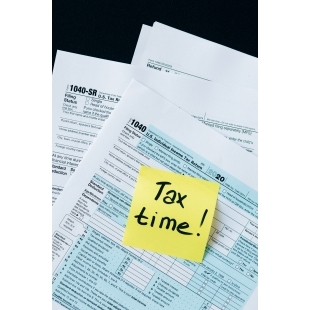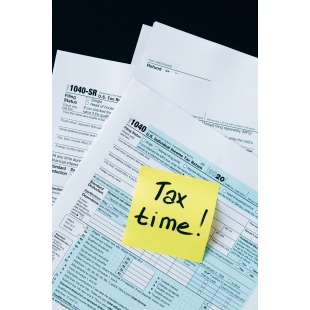All News
-

Some things to know about crowdfunding and taxes
Tax Tip 2022-120, August 8, 2022
Crowdfunding is a popular way to raise money online. People often use crowdfunding to fundraise for a business, for charity, or for gifts. It's important to know that money raised through crowdfunding may be taxable.
Some money raised through crowdfunding may be considered a gift.
Under federal tax law, gross income includes all income from any source, unless it's excluded from gross income by law. In most cases, gifts aren't included in the gross income of the person receiving the gift. Here's what people involved in crowdfunding should know:
If a crowdfunding organizer is raising money on behalf of others, the money may not be included in the organizer's gross income, as long as the organizer gives the money to the person for whom they organized the crowdfunding campaign.
If people donate to a crowdfunding campaign out of generosity and without expecting anything in return, the donations are gifts. Therefore, they will not be included in the gross income of the person for whom the campaign was organized.
However, not all contributions to crowdfunding campaigns are gifts and may be taxable.
When employers give to crowdfunding campaigns for an employee, those contributions are generally included in the employee's gross income.
Taxpayers may want to consult a trusted tax pro for information and advice regarding how to treat amounts received from crowdfunding campaigns.
People may receive Form 1099-K for money raised through crowdfunding.
The crowdfunding website or its payment processor must file Form 1099-K, Payment Card and Third Party Network Transactions with the IRS if:
The amount raised is more than $600
Contributors to the crowdfunding campaign receive goods or services for their contributions.
If a Form 1099-K is filed, the crowdfunding organizer or the beneficiary of the fundraiser will receive a copy, depending on who received the funding directly from the crowdfunding website.
Receiving a Form 1099-K doesn't automatically mean the amount shown is taxable. However, if the taxpayer doesn't include the distributions from the form on their tax return, the IRS may contact the recipient for more information. The recipient may need to explain why the crowdfunding distributions weren't reported.
Recordkeeping for money raised through crowdfunding.
People who run crowdfunding campaigns or receive money from one should keep careful records about the campaign and the disposition of funds for at least three years.
More information:
About Form 1099-K, Payment Card and Third Party Network Transactions
Understanding Your Form 1099-K
General FAQs on Payment Card and Third Party Network Transactions
Gig Economy Tax Center
Money received through "crowdfunding" may be taxable; taxpayers should understand their obligations and the benefits of good recordkeeping
Source: https://www.irs.gov/newsroom/some-things-to-know-about-crowdfunding-and-taxes
US TAX, U.S. TAXSome things to know about crowdfunding and taxesmore -

Aug. 13 華城移民 Live Broadcast Seminar
May 28 Metropolitan Immigration Consulting Group Seminar, Joy Yang is the only accountant be invited.Aug. 13 華城移民 Live Broadcast Seminarmore -

ABLE accounts can help people with disabilities pay for disability-related expenses
People with disabilities can use an Achieving a Better Life Experience or ABLE account to help pay qualified disability-related expenses. This tax-advantaged savings account doesn't affect their eligibility for government assistance programs.
Here are some key things people should know about these accounts.
Annual contribution limit
The 2022 limit is $16,000.
Certain employed ABLE account beneficiaries may make an additional contribution up to the lesser of these amounts:
The designated beneficiary's compensation for the tax year.
The poverty line for a one-person household. For 2022, this amount is $12,880 in the continental U.S., $16,090 in Alaska and $14,820 in Hawaii.
Saver's credit
ABLE account designated beneficiaries may be eligible to claim the saver's credit for a percentage of their contributions.
The beneficiary claims the credit on Form 8880, Credit for Qualified Retirement Savings ContributionsPDF. The saver's credit is a non-refundable credit available to individuals who meet these three requirements:
Are at least 18 years old at the close of the taxable year
Are not a dependent or a full-time student
Meet the income requirements
Rollovers and transfers from section 529 plans
Families may roll over funds from a 529 plan to another family member's ABLE account.
The ABLE account must be for the same beneficiary as the 529 account or for a member of the same family as the 529 account holder. Rollovers from a section 529 plan count toward the annual contribution limit. For example, the $16,000 annual contribution limit would be met by parents contributing $10,000 to their child's ABLE account and rolling over $6,000 from a 529 plan to the same ABLE account.
Qualified disability expenses
States can offer ABLE accounts to help people who become disabled before age 26 or their families pay for disability-related expenses. These expenses include housing, education, transportation, health, prevention and wellness, employment training and support, assistive technology and personal support services.
Though contributions aren't deductible for federal tax purposes, distributions, including earnings, are tax-free to the beneficiary, if they are used to pay qualified disability expenses.
More Information:
ABLE Accounts – Tax Benefit for People with Disabilities
Publication 907, Tax Highlights for Persons with Disabilities
Form 1099-QA, Distributions from ABLE Accounts PDF
Form 5498-QA, ABLE Account Contribution InformationPDF
Instructions for Forms 1099-QA and 5498-QA PDF
Source:https://www.irs.gov/newsroom/able-accounts-can-help-people-with-disabilities-pay-for-disability-related-expenses
US TAX, U.S. TAXABLE accounts can help people with disabilities pay for disability-related expensesmore -

People without a filing requirement may miss out on a refund if they don’t file a 2021 tax return
Some people may choose not to file a tax return because they didn't earn enough money to be required to file but may miss getting a refund if they don't file. While the filing deadline is October 17, 2022 to file 2021 tax returns, the IRS strongly encourages individuals to consider filing electronically sooner, rather than later, especially if they're due a refund.
In most cases, income, filing status and age determine if a taxpayer must file a tax return. Other rules may apply if the taxpayer is self-employed or can be claimed as a dependent of someone else. The Interactive Tax Assistant can help people determine if they need to file a tax return.
Look at tax withheld or paid. Excess tax withholdings are only returned in the form of a refund when someone files a tax return. This can affect students and part-time workers where the tax withheld from their wages is at a rate that is too high. Seniors and retirees who make estimated tax payments or have money withheld from their retirement fund and Social Security disbursements may also be eligible for a refund.
Individuals who answer yes to any of these questions, may be due a refund and must file a tax return to get their money.
Did the taxpayer's employer withhold federal income tax from their pay?
Did the taxpayer make estimated tax payments during the tax year?
Did they overpay last year on their taxes and have it applied to their 2021 tax?
Here are some valuable credits taxpayers may be able to claim. While most tax credits can be used to reduce the tax owed, there are credits that allow individuals to receive money beyond what they owe.
Recovery rebate credit Individuals who didn't qualify for a third Economic Impact Payment or got less than the full amount, may be eligible to claim the 2021 recovery rebate credit and will need to file a 2021 tax return even if they don't usually file a tax return. The credit will reduce any tax owed for 2021 or be included in the tax refund.
Earned income tax credit A working taxpayer who earned $57,414 or less last year could receive the EITC as a tax refund. For the 2021 tax year, the tax return taxpayers file in 2022, the earned income credit ranges from $1,502 to $6,728 depending on their filing status and how many children they claim on their tax return. Taxpayers who did not file a return for tax year 2020 or 2021 or who did not claim the earned income tax credit on their 2020 or 2021 return because they had no earned income in those years may file an original or amended return to claim the credit using their 2019 earned income if they are otherwise eligible to do so.
Taxpayers can also use their 2019 earned income to figure their 2021 earned income credit if their 2019 earned income is more than their 2021 earned income. They can check eligibility by using the EITC Assistant on IRS.gov, which is available in eight different languages.
Child tax credit or credit for other dependents Taxpayers can claim the child tax credit if they have a qualifying child under the age of 18 and meet other qualifications. Other taxpayers may be eligible for the credit for other dependents. This includes people who have:
Dependents who are age 17 or older.
Dependents who have individual taxpayer identification numbers.
Dependent parents or other qualifying relatives supported by the taxpayer.
Dependents living with the taxpayer who aren't related to the taxpayer.
This Interactive Tax Assistant tool on IRS.gov can help people determine if they qualify for these two credits.
Education credits There are two higher education credits that can reduce the amount of tax someone owes on their tax return. One is the American opportunity tax credit and the other is the lifetime learning credit. The taxpayer, their spouse or their dependent must have been a student enrolled at least half time for one academic period to qualify. The taxpayer may qualify for one of these credits even if they don't owe any taxes. Form 8863, Education Credits is used to claim the credit when filing the tax return.
Source:https://www.irs.gov/newsroom/people-without-a-filing-requirement-may-miss-out-on-a-refund-if-they-dont-file-a-2021-tax-return
US TAX, U.S. TAXPeople without a filing requirement may miss out on a refund if they don’t file a 2021 tax returnmore -

2021 tax extension filers don’t need to wait until October 17
The Internal Revenue Service is reminding the estimated 19 million taxpayers who requested an extension to file their 2021 tax return that they don't have to wait until mid-October to file. If a taxpayer has all the necessary information to file an accurate return, they can file electronically at any time before the October deadline and avoid a last-minute rush to file.
Taxpayers who requested more time to file an accurate return have until October 17, 2022. Those who have what they need to file, however, should file as soon as possible to avoid delays in processing their return.
Taxpayers who have questions can get help with most tax issues online or by phone. The IRS.gov website has free and easy to use online tools and resources to help taxpayers get answers 24 hours a day. Voice bots help callers navigate interactive voice responses to simple payment or notice questions, and quickly get responses to Frequently Asked Questions.
The Interactive Tax Assistant is a tool that provides answers to several tax law questions specific to individual circumstances based on input. It can determine if an individual must file a tax return, their filing status, if they can claim a dependent, if an income type is taxable, and their eligibility to claim a credit or deduct certain expenses.
Electronic filing options
The IRS advises individuals who still need to file a 2021 tax return to file electronically and, if due a refund, to choose direct deposit.
Filing electronically is fast, accurate and secure, and when an individual chooses direct deposit, their refund goes directly from the IRS into their bank or financial account getting them their refund in the fastest time possible. If they have a prepaid debit card, they may be able to have their refund applied to the card by providing the account and routing number to the IRS. The IRS processes most e-filed returns and issues direct deposit refunds in less than 21 days.
Tax professionals
There are also various types of tax return preparers who can help, including certified public accountants, enrolled agents, attorneys and others who don't have a professional credential.
Taxpayers should choose a tax preparer wisely. For individuals who want help with their taxes, the IRS online directory can assist in finding a tax professional in their area.
Get current on taxes
The IRS sends correspondence to a taxpayer's last known address, usually the address from their most recently filed tax return. If the taxpayer moves and does not send a change of address to the IRS, they may not receive an IRS notice and could miss the deadline to respond.
There's no penalty for not filing a return if due a refund, but there's also no statute of limitations for assessing and collecting taxes due if no return has been filed.
Interest is charged on any tax not paid by the April due date and will accrue until paid in full. Individual taxpayers are charged the federal short-term interest rate plus 3 percentage points, currently 5% per year, compounded daily. Penalties will accrue for each month tax remains unpaid until maxed out at 25% of the unpaid tax.
Submitting a tax return and paying any amount owed as soon as possible can help taxpayers avoid further interest and penalties.
Taxpayers who owe taxes can review all payment options online. These include paying taxes through an Online Account with IRS Direct Pay or paying by debit card, credit card or digital wallet. The IRS has options for people who can't pay their taxes, including applying for a payment plan on IRS.gov.
For more information, see:
IRS encourages taxpayers with October filing extensions and others who still need to file
Do I Need to File a Tax Return
What to Do if You Haven't Filed Your Tax Return
Voice bot video
Self-service options
Source: https://www.irs.gov/newsroom/2021-tax-extension-filers-dont-need-to-wait-until-october-17
US TAX, U.S. TAX2021 tax extension filers don’t need to wait until October 17more -

Recovery Rebate Credit
The IRS has issued all first, second and third Economic Impact Payments. Most eligible people already received their stimulus payments and won't be eligible to claim a Recovery Rebate Credit.
People who are missing a stimulus payment or got less than the full amount may be eligible to claim a Recovery Rebate Credit on their 2020 or 2021 federal tax return.
The first and second rounds of Economic Impact Payments were advance payments of the 2020 Recovery Rebate Credit claimed on a 2020 tax return. They were issued in 2020 and early 2021.
The third round of Economic Impact Payments, including the plus-up payments, were advance payments of the 2021 Recovery Rebate Credit claimed on a 2021 tax return. It was issued starting in March 2021 and continued through December 2021.
Individuals should review the information below to determine their eligibility to claim a Recovery Rebate Credit for tax year 2020 or 2021.
Find the Amount of your First, Second and Third Economic Impact Payment
It is critical that eligible individuals claiming a Recovery Rebate Credit understand that the advance payments applied to different tax years. Depending on which advance payment is missing – the first, second or third payment – you will file either a 2020 or 2021 tax return to claim a Recovery Rebate Credit.
Missing first and second payments may only be claimed on a 2020 tax return.
Missing third payments may only be claimed on a 2021 tax return.
You will need the tax year(s) and amount(s) of the Economic Impact Payments you received to accurately calculate the Recovery Rebate Credit. Enter the amount in your tax preparation software or in the Form 1040 Recovery Rebate Credit Worksheet to calculate your credit.
Having this information will help individuals determine if they are eligible to claim the 2020 or 2021 Recovery Rebate Credit for missing stimulus payments. Using the total amounts of the payments can reduce errors and avoid delays in processing while the IRS corrects the tax return.
To find the amount of your Economic Impact Payments, check:
Your Online Account: Securely access your IRS online account to view the total amount of your first, second and third Economic Impact Payment amounts under the Tax Records page.
IRS Notices : We mailed these notices to the address we have on file.
Notice 1444: Shows the first Economic Impact Payment advanced for tax year 2020
Notice 1444-B: Shows the second Economic Impact Payment advanced for tax year 2020
Notice 1444-C: Shows the third Economic Impact Payment advanced for tax year 2021
Letter 6475: Through March 2022, we'll send this letter confirming the total amount of the third Economic Impact Payment and any plus-up payments you received for tax year 2021.
How to claim the 2021 Recovery Rebate Credit\
The IRS is no longer issuing third Economic Impact Payments.
If you received the full amount of the third Economic Impact Payment, you don't need to include any information about your payment when you file your 2021 tax return.
If you didn't qualify for a third Economic Impact Payment or got less than the full amount, you may be eligible to claim the 2021 Recovery Rebate Credit when you file your 2021 tax return. You must file a return to claim the credit, even if you don't usually file a tax return. The credit is based on your 2021 tax year information, so any third Economic Impact Payments you received will reduce the amount of the credit you're eligible for. Your 2021 Recovery Rebate Credit will reduce any tax you owe for 2021 or be included in your tax refund.
You will need the total amount of your third Economic Impact payment and any plus-up payments to claim the 2021 Recovery Rebate Credit. Using the total amount of the third payments from the individual's online account or Letter 6475 when filing a tax return can reduce errors and avoid delays in processing while the IRS corrects the tax return.
Do not include amounts of missing first or second stimulus payments on your 2021 tax return. Instead, see How to Claim the 2020 Recovery Rebate Credit.
File your 2021 tax return electronically and the tax software will help you figure your 2021 Recovery Rebate Credit. Your Recovery Rebate Credit will reduce the amount of any tax you may owe for 2021 or be included in your tax refund, and can be direct deposited into your financial account. You can use a bank account, prepaid debit card or alternative financial products for your direct deposit. You will need to provide routing and account numbers.
How to claim the 2020 Recovery Rebate Credit
All first and second Economic Impact Payments have been sent out by the IRS. If you didn't get a first and second Economic Impact Payment or got less than the full amounts, you may be eligible to claim the 2020 Recovery Rebate Credit by filing a 2020 tax return if you have not filed yet or by amending your 2020 tax return if it's already been processed. Your Recovery Rebate Credit on your 2020 tax return will reduce the amount of tax you owe for 2020 or be included in your tax refund. Here's how eligible individuals claim the credit:
Do Not claim any missing first or second payments on your 2021 tax return.
File a 2020 tax return if you have not filed one yet or amend your 2020 tax return if your 2020 return has already been processed. Your Recovery Rebate Credit on your 2020 tax return will reduce the amount of tax you owe for 2020 or be included in your tax refund. Here's how eligible individuals claim the credit:
If you did not file a 2020 tax return or successfully use the Child Tax Credit Non-filer Sign-up Tool:
File a 2020 tax return to claim the 2020 Recovery Rebate Credit even if you don't usually file a tax return.
See the 2020 FAQs Recovery Rebate Credit — Topic A: Claiming the Recovery Rebate Credit if you aren't required to file a tax return.
If you did file a 2020 tax return or successfully used the Child Tax Credit Non-filer Sign-up Tool and did not claim a Recovery Rebate Credit:
File an amended return to claim the credit.
See the 2020 FAQs Recovery Rebate Credit — Topic G: Correcting issues after the 2020 tax return is filed.
If you filed a 2020 tax return or successfully used the Child Tax Credit Non-filer Sign-up Tool and you received a letter from the IRS about your 2020 Recovery Rebate Credit:
If you agree with the changes we made, you don't need to reply. Keep the letter with your tax records.
If you disagree, call us at the toll-free number listed on the top right corner of your notice. If you received a letter from the IRS about other issues relating to your tax return, you should follow the instructions in the letter.
See the 2020 FAQs Recovery Rebate Credit — Topic G: Correcting issues after the 2020 tax return is filed.
If your 2020 return or information has not yet been processed
Do not file a second tax return. Some returns need special handling to correct errors or credit amounts, which can delay processing by up to 120 days. The IRS is having to correct significantly more errors on 2020 tax returns than in previous years. If we correct the credit claimed on your return, we will send you an explanation.
Source:https://www.irs.gov/newsroom/recovery-rebate-credit
US TAX, U.S. TAXRecovery Rebate Creditmore -

IRS revises the 2021 Child Tax Credit and Advance Child Tax Credit frequently asked questions
FAQs
Note: These FAQs supersede earlier FAQs that were posted in FS-2022-29 on May 20, 2022.
This Fact Sheet updates the 2021 Child Tax Credit and Advance Child Tax Credit frequently asked questions (FAQs). These updates are to help eligible families properly claim the credit when they prepare and file their 2021 tax return.
Q1. What are advance Child Tax Credit payments? (updated May 20, 2022)
Advance Child Tax Credit payments are early payments from the IRS of 50 percent of the estimated amount of theChild Tax Credit that you may properly claim on your 2021 tax return. If the IRS processed your 2020 tax return or 2019 tax return before the end of June 2021, these monthly payments began in July and continued through December 2021, based on the information contained in that return.
Note: Advance Child Tax Credit payment amounts were not based on the Credit for Other Dependents, which is not refundable. For more information about the Credit for Other Dependents, see IRS Schedule
8812 (Form 1040), Credits for Qualifying Children and Other Dependents.
Q2. What did I need to do to receive advance Child Tax Credit payments? (updated May 20, 2022)
Generally, nothing. If you were eligible to receive advance Child Tax Credit payments based on your 2020 tax returnor 2019 tax return (including information you entered into the Non-Filer tool for Economic Impact Payments on IRS.govin 2020, or the Child Tax Credit Non-filer Sign-up Tool in 2021), you generally received those payments automatically without needing to take any additional action.
Disbursement of advance Child Tax Credit payments began in July and continued on a monthly basis through December 2021, generally based on the information contained in your 2019 or 2020 federal income tax return. If you are eligible for the Child Tax Credit, but did not receive advance Child Tax Credit payments, you can claim the full credit amount when you file your 2021 tax return.
For more information regarding eligibility and how advance Child Tax Credit payments have been disbursed, see
Topic B: Eligibility for Advance Child Tax Credit Payments and the 2021 Child Tax Credit
and
Topic E: Advance Payment Process of the Child Tax Credit
Q3. Did I need income to receive advance Child Tax Credit payments? (updated May 20, 2022)
No. Even if you had $0 in income, you could have received advance Child Tax Credit payments if you were eligible. Disbursement of advance Child Tax Credit payments began in July and continued on a monthly basis through December 2021, generally based on the information contained in your 2019 or 2020 federal income tax return. If you are eligible for the Child Tax Credit, but did not receive advance Child Tax Credit payments, you can claim the full credit amount when you file your 2021 tax return.
For information regarding eligibility, see
Topic B: Eligibility for Advance Child Tax Credit Payments and the 2021 Child Tax Credit.
Q4. Where can I get help completing my 2021 tax return if I can’t do it myself? (updated May 20, 2022)
If you could not or chose not to use IRS Free File or Free File Fillable Forms to file your 2021 tax return, there are various types of tax return preparers, including certified public accountants,enrolled agents, attorneys, and others who can assist you in filing your return. For more information about these and other return preparers who might be right for you, visit
Need someone to prepare your tax return?
Disbursement of advance Child Tax Credit payments began in July and continued on a monthly basis through December 2021, generally based on the information contained in your 2019 or 2020 federal income tax return. If you are eligible for the Child Tax Credit, but did not receive advance Child Tax Credit payments, you can claim the full credit amount when you file your 2021 tax return.
Q5. What if I did not want to receive advance Child Tax Credit payments? (updated May 20, 2022)
If you preferred not to receive monthly advance Child Tax Credit payments because you would rather claim the full credit when you file your 2021 tax return, or you knew you were not eligible for the Child Tax Credit for your 2021 tax year, the IRS provided an option to unenroll from advance Child Tax Credit payments through the Child Tax CreditUpdate Portal (CTC UP).
Q6. When did the IRS begin disbursing advance Child Tax Credit payments? (updated January 11, 2022)
The IRS began disbursing advance Child Tax Credit payments on July 15. After that, payments were disbursed on a monthly basis through December 2021.
For more information regarding how advance Child Tax Credit payments were disbursed, see
Topic E: Advance Payment Process of the Child Tax Credit.
Q7. Did the IRS contact individuals about advance Child Tax Credit payments before they were disbursed? (updated January 11, 2022)
Yes. In June 2021, the IRS sent Letter 6417. This letter informed recipients of the amount of their estimated Child Tax Credit monthly payments. This letter also indicated where recipients could find additional information about advance Child Tax Credit payments.
Q8. How could I have qualified for advance Child Tax Credit payments? (updated May 20, 2022)
You qualified for advance Child Tax Credit payments if you had a qualifying child. Also, you — or your spouse, if married filing a joint return — must have had your main home in one of the 50 states or the District of Columbia for more than half the year. Your main home can be any location where you regularly live. Your main home may be your house, apartment, mobile home, shelter, temporary lodging, or other location and doesn’t need to be the same physicallocation throughout the taxable year. You don’t need a permanent address to get these payments. If you are temporarily away from your main home because of illness, education, business, vacation, or military service, you are generally treated as living in your main home.
Disbursement of advance Child Tax Credit payments began in July and continued on a monthly basis through December 2021, generally based on the information contained in your 2019 or 2020 federal income tax return. If you are eligible for the Child Tax Credit, but did not receive advance Child Tax Credit payments, you can claim the full credit amount when you file your 2021 tax return.
For more information regarding eligibility for advance Child Tax Credit payments, and the Child Tax Credit generally, see
Topic B: Eligibility for Advance Child Tax Credit Payments and the 2021 Child Tax Credit.
For information on how the amount of your Child Tax Credit could be reduced based on the amount of your income, see
Topic C: Calculation of the 2021 Child Tax Credit.
Q9. Will receiving advance Child Tax Credit payments cause a delay in my refund when I file my 2021 tax return? (updated May 20, 2022)
No. However, if you fail to properly reconcile your advance Child Tax Credit payments with the amount of Child Tax Credit for which you are eligible on your 2021 federal income tax return, processing of your return by the IRS will be delayed.
For more information regarding how to reconcile your advance Child Tax Credit payments with your Child Tax Credit on your 2021 tax return, see
Topic H: Reconciling Your Advance Child Tax Credit Payments on Your 2021 Tax Return.
Q10. Are advance Child Tax Credit payments taxable? (updated May 20, 2022)
No. Advance Child Tax Credit payments are not income and will not be reported as income on your 2021 tax return. Advance Child Tax Credit payments are advance payments of your tax year 2021 Child Tax Credit.
However, the total amount of advance Child Tax Credit payments that you received during 2021 was based on the IRS’s estimate of your 2021 Child Tax Credit. If the total of your advance Child Tax Credit payments is greater than the Child Tax Credit amount that you are allowed to claim on your 2021 tax return, you may have to repay the excess amount on your 2021 tax return. For example, if you received advance Child Tax Credit payments for two qualifying children properly claimed on your 2020 tax return, but you no longer have qualifying children in 2021,the advance Child Tax Credit payments that you received based on those children are added to your 2021 income tax unless you qualify for repayment protection. For more information regarding your eligibility for repayment protection, and how to reconcile your advance Child Tax Credit payments with your Child Tax Credit on your 2021 tax return, see
Topic H: Reconciling Your Advance Child Tax Credit Payments on Your 2021 Tax Return.
Q11. Will the IRS send me a letter about my advance Child Tax Credit payments to help me claim the correct Child Tax Credit amount on my 2021 return during the 2022 tax filing season? (updated May 20, 2022)
Yes. In January 2022, the IRS sent Letter 6419 to provide the total amount of advance Child Tax Credit payments that were disbursed to you during 2021. Please keep this letter regarding your advance Child Tax Credit payments with your tax records. You may need to refer to this letter when you file your 2021 tax return.
For more information regarding this letter and how to reconcile your advance Child Tax Credit payments with your Child Tax Credit on your 2021 return, see
Topic H: Reconciling Your Advance Child Tax Credit Payments on Your 2021 Tax Return.
Q12. Will advance Child Tax Credit payments affect any government benefits that I receive? (updated January 11, 2022)
No. Advance Child Tax Credit payments cannot be counted as income when determining if you or anyone else is eligible for benefits or assistance, or how much you or anyone else can receive, under any federal program or under any state or local program financed in whole or in part with federal funds. These programs also cannot count advance Child Tax Credit payments as a resource for purposes of determining eligibility for at least 12 months after you receive them.
Q A13. Can I call the IRS or my tax software company or bank to update my bank account information for advance Child Tax Credit payments? (updated May 20, 2022)
The IRS launched on IRS.gov a Child Tax Credit Update Portal (CTC UP), which allowed you to update informationwith the IRS. The portal is no longer available, and the IRS has completed disbursing advance Child Tax Credit payments.
If you file a 2021 return, the IRS will use the bank account information you enter on your tax return to send your refund, if you are receiving one.
Q14. How do I avoid scams relating to advance Child Tax Credit payments? (updated May 20, 2022)
The IRS has urged everyone to be on the lookout for scam artists trying to use advance Child Tax Credit payments or the Child Tax Credit as a cover for schemes to steal personal information and money. The IRS doesn't initiate contact by email, text messages, or social media channels to request personal or financial information – even information related to advanceChild Tax Credit payments. Also, watch out for emails with attachments or links claiming to have special information about advance Child Tax Credit payments or refunds of the Child Tax Credit.
If you receive a suspicious IRS-related email, see
Report Phishing and Online Scams for additional information.
Q15. I want to help spread the news about the Child Tax Credit within my community. How can I do that? (updated May 20, 2022)
The IRS has materials and information that can be easily shared by social media, email, and other methods. The IRS urges employers, community groups, non-profits, associations, education groups, and anyone else with connections to people with children to share information about the Child Tax Creditexpansions for the 2021 tax year. You can find materials to share at
2021 Child Tax Credit and Advance Child Tax Credit Payments: Resources and Guidance
.
The IRS will continue to provide materials on how to claim the 2021 Child Tax Credit, as well as how to reconcile your advance Child Tax Credit payments with the amount of 2021 Child Tax Credit forwhich you are eligible. For more information regarding how to reconcile your advance Child Tax Credit payments with your Child Tax Credit on your 2021 tax return, see
Topic H: Reconciling Your Advance Child Tax Credit Payments on Your 2021 Tax Return.
Disbursement of advance Child Tax Credit payments began in July and continued on a monthly basis through December 2021, generally based on the information contained in your 2019 or 2020 federal income tax return. If you are eligible for the Child Tax Credit, but did not receive advance Child Tax Credit payments, you can claim the full credit amount when you file your 2021 tax return.
Q16. When was I able to update my information? (updated May 20, 2022)
Updates made by 11:59 pm Eastern Time on November 29 were reflected in the monthly payment disbursed in December. Updates to the number of qualifying children or filing status should be made when you file your 2021 tax return
2021 Monthly deadlines to make changes to your information
Date You Can Make Changes
What You Can Do
June 21, 2021
• Find out if you’re eligible
• Unenroll from payments
• See a list of your payments
June 30, 2021
• Make changes to your bank information
August 20, 2021
• Make changes to your address
November 1, 2021
• Make changes to your income
November 29, 2021
• Final date to update information on Child Tax Credit Update Portal to impact advance Child Tax Credit payments disbursed in December.
• Child Tax Credit Update Portal available in Spanish
Source: https://www.irs.gov/pub/taxpros/fs-2022-32.pdf
US TAX, U.S. TAX
IRS revises the 2021 Child Tax Credit and Advance Child Tax Credit frequently asked questionsmore -

IRS continues work on inventory of tax returns; original tax returns filed in 2021 to be completed this week
IR-2022-128, June 21, 2022
WASHINGTON — Following intensive work during the past several months, the Internal Revenue Service announced today that processing on a key group of individual tax returns filed during 2021 will be completed by the end of this week.
Due to issues related to the pandemic and staffing limitations, the IRS began 2022 with a larger than usual inventory of paper tax returns and correspondence filed during 2021. The IRS took a number of steps to address this, and the agency is on track to complete processing of originally filed Form 1040 (individual tax returns without errors) received in 2021 this week.
Business paper returns filed in 2021 will follow shortly after. The IRS continues to work on the few remaining 2021 individual tax returns that have processing issues or require additional information from the taxpayer.
As of June 10, the IRS had processed more than 4.5 million of the more than 4.7 million individual paper tax returns received in 2021. The IRS has also successfully processed the vast majority of tax returns filed this year: More than 143 million returns have been processed overall, with almost 98 million refunds worth more than $298 billion being issued.
IRS employees continue working hard to process these and other tax returns filed in the order received. The IRS continues to receive current and prior-year individual returns and related correspondence as people file extensions, amended returns and a variety of business tax returns.
To date, more than twice as many returns await processing compared to a typical year at this point in the calendar year, although the IRS has worked through almost a million more returns to date than it had at this time last year. And a greater percentage of this year's inventory awaiting processing is comprised of original returns which, generally, take less time to process than amended returns.
To work to address the unprocessed inventory by the end of this year, the IRS has taken aggressive, unprecedented steps to accelerate this important processing work while maintaining accuracy. This effort included significant, ongoing overtime for staff throughout 2022, creating special teams of employees focused solely on processing aged inventory, and expediting hiring of thousands of new workers and contractors to help with this ongoing effort.
Additionally, the IRS has greatly improved the process for taxpayers whose paper and electronically filed returns were suspended during processing for manual review and correction – referred to as error resolution. Last filing season, an IRS tax examiner could correct an average of 70 tax returns with errors per hour. Thanks to new technology implemented this filing season, 180 to 240 returns can now be corrected per hour. As of June 12, 2021, there were 8.9 million tax returns in error resolution. As of June 10, 2022, there were just 360,000 returns awaiting correction.
The IRS will continue its intense effort to make progress on processing these paper returns in the months ahead.
Source:https://www.irs.gov/newsroom/irs-continues-work-on-inventory-of-tax-returns-original-tax-returns-filed-in-2021-to-be-completed-this-week
US TAX, U.S. TAXIRS continues work on inventory of tax returns; original tax returns filed in 2021 to be completed this weekmore -

Questions and Answers about the Third-round Economic Impact Payment
These updated FAQs were released to the public in Fact Sheet 2022-22PDF, March 25, 2022.
If you didn't receive, or get the full amount of, the third-round Economic Impact Payment, you may be eligible to claim the 2021 Recovery Rebate Credit and must file a 2021 tax return – even if you don't usually file taxes – to claim it. Your 2021 Recovery Rebate Credit will reduce any tax you owe for 2021 or be included in your tax refund.
If your income is $73,000 or less, you can file your federal tax return electronically for free through the IRS Free File Program. The fastest and most secure way to get your tax refund is to file electronically and have it direct deposited, contactless and free, into your financial account. You can have your refund direct deposited into your bank account, prepaid debit card, or mobile app, and will need to provide routing and account numbers.
If you didn't get the full amounts of the first- and second-round Economic Impact Payments, you may be eligible to claim the 2020 Recovery Rebate Credit and must file a 2020 tax return – even if you don't usually file taxes – to claim it. DO NOT include any information regarding the first- and second-round Economic Impact Payments or the 2020 Recovery Rebate Credit on your 2021 return.
Below are links to the frequently asked questions about the third-round Economic Impact Payment, separated by topic. Please do not call the IRS. Our phone assistors don't have information beyond what's available on IRS.gov.
The Third-round Economic Impact Payment was authorized by the American Rescue Plan Act of 2021 as an advance payment of the 2021 Recovery Rebate Credit.
The IRS started sending the third-round Economic Impact Payments to eligible individuals in March 2021 and continued sending payments throughout the year as tax returns were processed.
The IRS has issued all third-round Economic Impact Payments (including all plus-up payments).
Families and individuals in the following circumstances, among others, may not have received the full amount of their third-round Economic Impact Payment because their circumstances in 2021 were different than they were in 2020. These families and individuals may be eligible to receive more money by claiming the 2021 Recovery Rebate Credit on their 2021 income tax return:
Parents of a child born in 2021 who claim the child as a dependent on their 2021 income tax return may be eligible to receive a 2021 Recovery Rebate Credit of up to $1,400 for this child.
All eligible parents of qualifying children born or welcomed through adoption or foster care in 2021 are also encouraged to claim the child tax credit — worth up to $3,600 per child born in 2021 — on their 2021 income tax return.
Families who added a dependent – such as a parent, a nephew or niece, or a grandchild – on their 2021 income tax return who was not listed as a dependent on their 2020 income tax return may be eligible to receive a 2021 Recovery Rebate Credit of up to $1,400 for this dependent.
Single filers who had incomes above $80,000 in 2020 but less than this amount in 2021; married couples who filed a joint return and had incomes above $160,000 in 2020 but less than this amount in 2021; and head of household filers who had incomes above $120,000 in 2020 but less than this amount in 2021 may be eligible for a 2021 Recovery Rebate Credit of up to $1,400 per person.
Single filers who had incomes between $75,000 and $80,000 in 2020 but had lower incomes in 2021; married couples who filed a joint return and had incomes between $150,000 and $160,000 in 2020 but had lower incomes in 2021; and head of household filers who had incomes between $112,500 and $120,000 in 2020 but had lower incomes in 2021 may be eligible for a 2021 Recovery Rebate Credit.
Individuals must claim the 2021 Recovery Rebate Credit on their 2021 income tax return in order to get this money; the IRS will not automatically calculate the 2021 Recovery Rebate Credit. The IRS began accepting 2021 income tax returns on January 24.
Most other eligible people already received the full amount of their credit in advance and don't need to include any information about this payment when they file their 2021 tax return.
Topic A: General Information
Topic B: Eligibility and Calculation of the Third Payment
Topic C: Plus-Up Payments
Topic D: EIP Cards
Topic E: Requesting My Payment
Topic F: Social Security, Railroad Retirement and Department of Veterans Affairs benefit recipients
Topic G: Receiving My Payment
Topic H: Reconciling on Your 2021 Tax Return
Topic I: Returning the Third-round Economic Impact Payment
Topic J: Payment Issued but Lost, Stolen, Destroyed or Not Received
Source:https://www.irs.gov/newsroom/questions-and-answers-about-the-third-round-economic-impact-payment
US TAX, U.S. TAXQuestions and Answers about the Third-round Economic Impact Paymentmore -

Low Income Taxpayer Clinic 2023 grant application period now open – National Taxpayer Advocate calls for applicants looking to serve their communities and uphold taxpayer rights
Low Income Taxpayer Clinic 2023 grant application period now open – National Taxpayer Advocate calls for applicants looking to serve their communities and uphold taxpayer rightsLow Income Taxpayer Clinic 2023 grant application period now open – National Taxpayer Advocate calls for applicants looking to serve their communities and uphold taxpayer rightsmore -

May. 28 Metropolitan Immigration Consulting Group Seminar
May 28 Metropolitan Immigration Consulting Group Seminar, Joy Yang is the only accountant be invited.May. 28 Metropolitan Immigration Consulting Group Seminarmore -

IRS announces 2022 funding for Low Income Taxpayer Clinic grant recipients
IRS announces 2022 funding for Low Income Taxpayer Clinic grant recipientsIRS announces 2022 funding for Low Income Taxpayer Clinic grant recipientsmore












